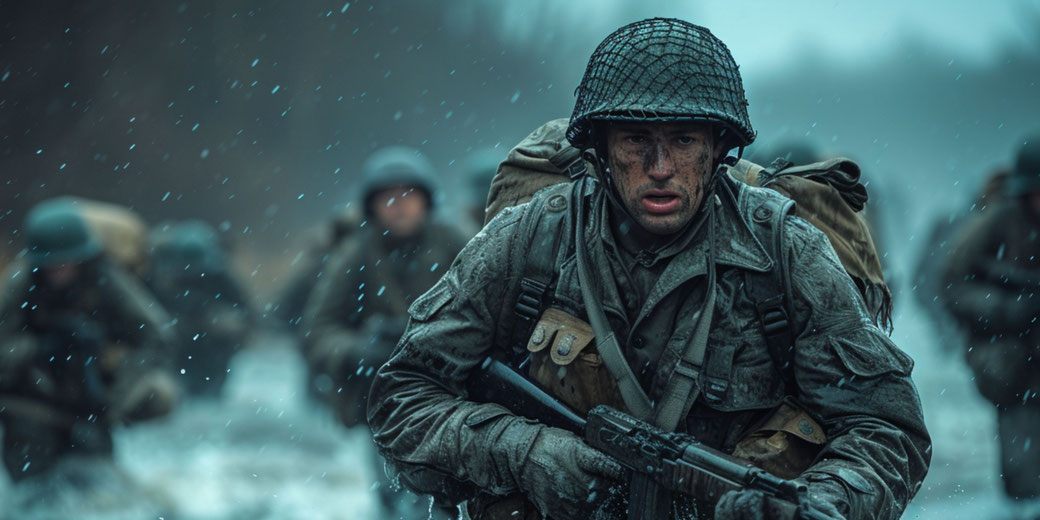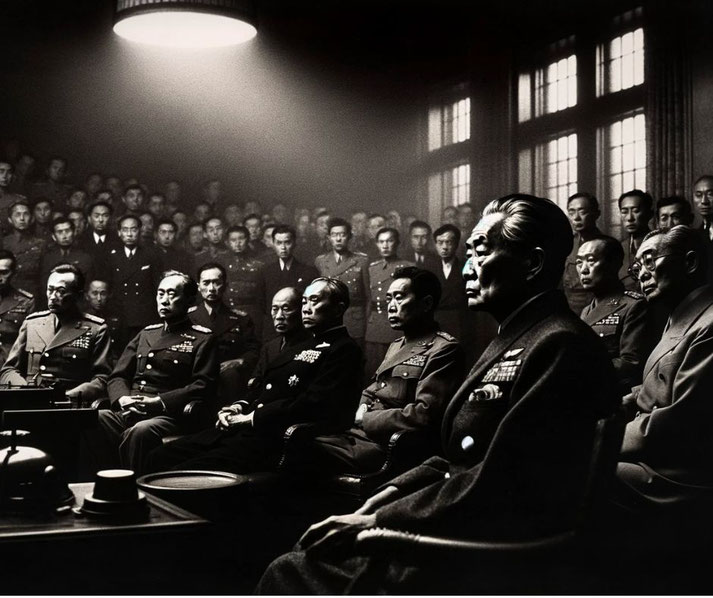Why America's planned invasion of Japan during WWII would have been an unmitigated disaster

As the Pacific sun set on a war-ravaged world in 1945, a shadow loomed over Japan, not of bombers or battleships, but of an invasion so colossal it threatened to eclipse D-Day in scale and ferocity.
Operation Downfall, the Allies' audacious plan to end World War II by invading Japan, promised a climax more bloody and dramatic than any battle before.
Yet, history books remain eerily silent on its execution. Why?
Because this grand operation, capable of altering the course of history and reshaping the modern world, never happened.
What lay behind the decision to abandon a fully planned invasion for a path that led, instead, to the abrupt end of the war with atomic fire?
Why did the US consider a land invasion of Japan?
In the final months of World War II, the Allied forces, having secured victory in Europe with Germany's unconditional surrender on May 8, 1945, turned their full military might towards Japan.
The Pacific War had been raging since December 7, 1941, with the attack on Pearl Harbor, and had seen some of the most brutal and intense fighting of the Second World War.
Islands such as Iwo Jima and Okinawa became the stages for fierce battles, demonstrating the Japanese forces' determination to fight to the last man.
As the Allies advanced closer to Japan's home islands, it became clear that ending the war would require a direct assault on Japan itself.
The concept for Operation Downfall was born out of this necessity.
Detailed planning began in earnest in early 1945, with the operation aiming to capture the southern island of Kyushu, and then later, a full-scale invasion of the main island, Honshu.
This plan was underpinned by the expectation of minimal Soviet involvement in the Pacific and the belief that an overwhelming show of force could compel Japan to surrender without the need for a mainland invasion.
How Operation Downfall was supposed to work
This ambitious operation was divided into two distinct phases: Operation Olympic and Operation Coronet.
Operation Olympic, the initial phase, was aimed at securing the southern island of Kyushu.
Scheduled for November 1945, it was intended to establish a stronghold from which the Allies could launch further operations and provide air support for the subsequent invasion of Honshu.
The plan called for a massive deployment of troops, with three corps assigned to land on Kyushu's southern beaches, facing an anticipated fierce resistance from well-entrenched Japanese forces.
Operation Coronet, set for March 1946, targeted the Kanto Plain, close to Tokyo on the main island of Honshu.
It envisioned an even larger force than Olympic, reflecting the operation's scope and the expected intensity of the Japanese defense.
The strategy for Coronet involved landing troops on the beaches of Honshu and pushing inland to capture Tokyo, effectively bringing the Japanese government to its knees.
The operation would be supported by a vast array of naval and air power, ensuring supremacy in both domains to protect the invading forces and cut off Japanese reinforcements and supplies.
Behind these plans lay a complex logistics operation. The Allies had to amass an unprecedented amount of men, ships, vehicles, and supplies, a task complicated by the need to maintain operations across multiple fronts worldwide.
Intelligence efforts intensified to gauge the strength and disposition of Japanese forces, with estimates suggesting Japan had over 2.3 million soldiers stationed in the Home Islands, supported by a civilian militia prepared for total war.
The strategy also accounted for potential chemical warfare and the integration of new technological advancements, including the potential use of atomic weapons as a last resort.
However, the primary focus remained on conventional warfare, with a heavy reliance on air superiority to weaken Japanese defenses ahead of the landings.
How Japan was preparing for the invasion
The Japanese high command, fully aware of the Allies' intentions to invade the home islands, initiated extensive preparations to defend against the anticipated assault.
These preparations were rooted in a strategy that combined traditional military defenses with a mobilization of the civilian population, reflecting a resolve to resist the invasion at all costs.
The Japanese military began fortifying the potential landing sites, especially around Kyushu and the Kanto Plain near Tokyo, areas identified as primary targets for the Allied landings.
These fortifications included beach defenses, bunkers, underground tunnels, and other fortifications designed to withstand bombing and artillery fire.
The strategy was to delay and disrupt the Allied landings, inflicting maximum casualties to weaken the invaders' resolve and capability to push inland.
In addition to conventional military preparations, Japan implemented a strategy of total national mobilization.
The Ketsu-Go plan called for the enlistment of all segments of Japanese society in the defense effort.
Civilians, including women and schoolchildren, were trained in basic combat and tactics, prepared to serve as a last line of defense.
This mobilization also saw the formation of volunteer corps and the distribution of rudimentary weapons, such as bamboo spears, demonstrating a commitment to a fight to the death rather than surrender.
The Japanese military also planned to employ kamikaze tactics on a scale never before seen.
These suicide attacks, which had been used with devastating effect against Allied naval forces earlier in the war, were to be expanded to include not just aircraft but also boats and human torpedoes.
The aim was to inflict severe damage on the Allied fleets, disrupting supply lines and troop landings.
The Japanese Navy and Air Force were reorganized to maximize the impact of these attacks, with pilots and crew members undergoing rigorous training for their suicide missions.
Efforts were made to mislead the Allies about the strength and disposition of Japanese forces, as well as the extent of Japan's defensive fortifications.
These measures aimed to cause confusion and hesitation among the Allied commanders, buying time for Japan's defensive preparations.

Why planners started having second thoughts
However, the anticipated casualty figures for Operation Downfall were staggering.
Estimates varied widely, with some figures suggesting that American casualties could range from several hundred thousand to over a million.
A study by the Joint War Plans Committee, dated June 15, 1945, anticipated up to 40,000 U.S. dead and 150,000 wounded in the first 30 days of Operation Olympic alone.
Further grim predictions for Operation Coronet suggested even higher numbers, given the denser population and more formidable defenses around Tokyo.
The prospect of such staggering casualties sparked significant opposition within both the military and political spheres.
High-ranking military officers, including General Douglas MacArthur, the Supreme Commander for the Allied Powers in the Pacific, and Admiral William Leahy, Chief of Staff to the Commander in Chief of the Army and Navy, expressed reservations about the operation's human cost.
Meanwhile, political leaders and strategists debated the moral and ethical implications of proceeding with an invasion that would undoubtedly lead to a vast number of deaths among combatants and civilians alike.
This opposition was not merely a matter of ethical concern but also reflected strategic considerations.
The potential loss of life raised questions about the post-war occupation and rebuilding of Japan, the political and social stability of the Asia-Pacific region, and the impact on U.S. domestic opinion.
These considerations, coupled with the emerging geopolitical context of the early Cold War period and the desire to limit Soviet influence in post-war Japan, influenced the decision-making process.
What the US chose to do instead of invading
The culmination of the Pacific War was dramatically influenced by two pivotal events in August 1945: the dropping of atomic bombs on Hiroshima and Nagasaki and the Soviet Union's declaration of war against Japan.
These developments profoundly shifted the strategic landscape, hastening Japan's surrender and obviating the need for Operation Downfall.
On August 6, 1945, an American B-29 bomber named Enola Gay dropped an atomic bomb on Hiroshima, instantly killing an estimated 70,000 people, with tens of thousands more dying in the following weeks from injuries and radiation sickness.
Three days later, a second bomb was dropped on Nagasaki, resulting in another catastrophic loss of life.
These bombings marked the first combat use of atomic weapons and demonstrated their devastating effectiveness.
The decision to use atomic bombs, made by President Harry S. Truman and his advisors, was driven by a desire to end the war swiftly and avoid the massive casualties anticipated from an invasion of Japan.
Simultaneously, the geopolitical landscape of the Pacific War was altered by the Soviet Union's declaration of war on Japan on August 8, 1945, breaking the Neutrality Pact signed between the two nations in 1941.
Soviet forces launched a massive offensive in Manchuria, quickly overwhelming Japanese forces in Northeast Asia.
This move by the Soviet Union, led by Joseph Stalin, was motivated by agreements made at the Yalta Conference, where Stalin had promised to enter the war against Japan after the defeat of Nazi Germany, in exchange for territorial concessions in Asia.
The combined shock of the atomic bombings and the Soviet entry into the war against them created a crisis within the Japanese government and military.
The inner circle of Japan's leadership, including Emperor Hirohito, Prime Minister Kantaro Suzuki, and the Supreme Council for the Direction of the War, known as the "Big Six," were faced with an unprecedented situation.
The prospect of additional atomic bombings and the fear of a Soviet invasion of the home islands forced a reevaluation of Japan's stance on surrender.
Despite initial resistance from hardliners within the military, the realization that continued resistance would result in the total destruction of Japan led to the decision to accept the terms of the Potsdam Declaration.
Emperor Hirohito, in a rare intervention in governmental affairs, played a crucial role in this decision, advocating for surrender to spare the Japanese people from "unbearable and total annihilation."
On August 15, 1945, Emperor Hirohito addressed the Japanese nation via radio, announcing the surrender of Japan and marking the end of World War II.
This broadcast, known as the Gyokuon-hoso (Jewel Voice Broadcast), was the first time many Japanese citizens had heard their emperor's voice.
In the years following World War II, the narrative surrounding Operation Downfall has evolved. Initially, information about the operation was not widely known outside military and governmental circles.
Over time, as details emerged and were made public, the operation has become a subject of interest for those studying the Pacific Theater, contributing to broader discussions about the use of atomic weapons and the ethical considerations of war.
The decision to use atomic bombs, while controversial, is often defended within historical discourse as having saved millions of lives that would have been lost in Operation Downfall.
This rationale, however, is not without its critics, who argue about the morality of using such weapons and whether other alternatives could have compelled Japan to surrender without the need for either the bombings or the invasion.
The debate is further complicated by the Soviet Union's entry into the war against Japan, a factor that some argue played a significant role in Japan's decision to surrender.
What do you need help with?
Download ready-to-use digital learning resources
Copyright © History Skills 2014-2024.
Contact via email
With the exception of links to external sites, some historical sources and extracts from specific publications, all content on this website is copyrighted by History Skills. This content may not be copied, republished or redistributed without written permission from the website creator. Please use the Contact page to obtain relevant permission.





